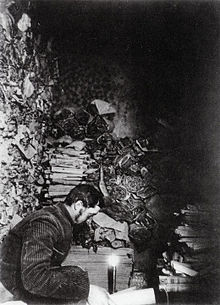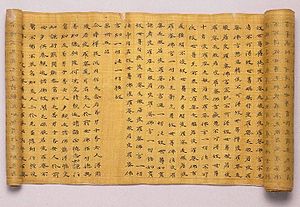- Dunhuang manuscripts
-
 Pelliot examines manuscripts in Mogao Caves cave 17
Pelliot examines manuscripts in Mogao Caves cave 17
The Dunhuang manuscripts is a cache of important religious and secular documents discovered in the Mogao Caves of Dunhuang, China during the early 20th century. Dating from the 5th to early 11th centuries, the manuscripts include works ranging from history and mathematics to folk songs and dance. While most of the religious documents are about Buddhism, there are a number on Taoism, Nestorianism, and even Judaism. They are written primarily in Chinese, but also include Tibetan, Pali, Sogdian, and previously unknown languages, such as Khotanese.
The documents were discovered by the Taoist monk Wang Yuanlu. He later sold them to Western explorers, notably Aurel Stein and Paul Pelliot. Russian and Japanese explorers also acquired some. But largely due to Luo Zhenyu's efforts, the remaining manuscripts were preserved in China. Those purchased by western scholars are now kept in institutions all over the world, such as the National Library of China, British Library, and the Bibliothèque nationale de France. They are all being digitised by the International Dunhuang Project, and can be accessed free online.
Contents
Classification
By language
The largest proportion of the manuscripts are written in Classical and vernacular Chinese. Other languages represented include Tibetan, Hebrew, Khotanese, Old Turkic, Sanskrit and Sogdian.
By genre
- Religious scriptures
- Buddhist, and those of Tibetan Buddhism
- Taoist, including the Hua Hu Jing, and the Xiang'er commentary to the Tao Te Ching
- Jewish, Selihot prayers
- Nestorian
- Manichaeist
- Philosophy, notably the Confucian classics, including an ancient edition of Analects commented by Huang Kan (皇侃), and ancient editions of the Shang Shu
- Literature
- Popular narratives of Buddhist motifs, known as bian wen (變文)
- Folk songs
- Classical poetry
- History, both official and local
- Geography, including the Wang wu tianzhu guo chuan
- Medicine
- Astronomy, including the Dunhuang star map
- Mathematics
- Divination
- Dictionaries, including fragments of the Qieyun
- Music scores
- Dance notations
- Social documents, such as contracts, account books and loan receipts
Dunhuang: Tibetan tantric documents recovered from the Mogao Caves
Dalton and Schaik (2007, revised) provide an excellent online catalogue listing 350 Tibetan Tantric Manuscripts from Dunhuang in the Stein Collection of the British Library which is currently fully accessible online in discrete digitized manuscripts; with the Wylie transcription of the manuscripts to be made available online in the future. [1]
Cantwell and Mayer (2008) open discourse into English on a number of texts recovered from the cache of the Dunhuang manuscripts that discuss the phurba and its ritual usage.[2]
Dzogchen texts
Samten Migdrön (Tib. bsam gtan mig sgron) is a Tibetan text of historical importance for the historical relationship of Dzogchen and Zen as well identifying the view of its author, Nubchen Sangye Yeshe. The Samten Migdron was recovered amongst the Dunhuang texts.[3]
See also
- Silk Road transmission of Buddhism
- Cairo Geniza, similar cache of ancient religious and secular documents
References
- ^ Dalton, Jacob & van Schaik, Sam (2007). Catalogue of the Tibetan Tantric Manuscripts from Dunhuang in the Stein Collection [Online]. Second electronic edition. International Dunhuang Project. Source: [1] (accessed: Tuesday February 2, 2010)
- ^ Cantwell, Cathy and Mayer, Robert. (2008). Early Tibetan Documents on Phur pa from Dunhuang. Vienna: OAW.
- ^ Source: [2] (accessed: Friday February 26, 2010)
- Cathy CANTWELL & Robert MAYER. Early Tibetan Documents on Phur pa from Dunhuang.
- "The Sweet Sage and The Four Yogas: A Lost Mahāyoga Treatise from Dunhuang." Sam van Schaik, The British Library. JIATS, no. 4 (December 2008), THL #T5564, 67 pp. © 2008 by Sam van Schaik, IATS, and THL
- Multilingualism in Tun-huang
External links

This article about a manuscript is a stub. You can help Wikipedia by expanding it. - Religious scriptures


